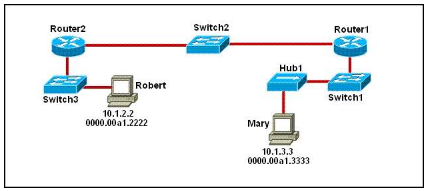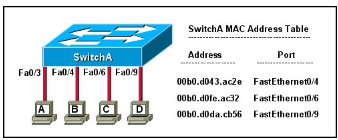READ Free Dumps For CISCO- 100-105
| Question ID 14413 | Refer to the exhibit.

As packets travel from Mary to Robert, which three devices will use the destination MAC
address of the packet to determine a forwarding path? (Choose three.)
|
| Option A | Hub1
|
| Option B | Switch1
|
| Option C | Router1
|
| Option D | Switch2
|
| Option E | Router2
|
| Option F | Switch3
|
| Correct Answer | B,D,F |
Explanation Explanation: Switches use the destination MAC address information for forwarding traffic, while routers use the destination IP address information. Local Area Networks employ Layer 2 Switches and Bridges to forward and filter network traffic. Switches and Bridges operate at the Data Link Layer of the Open System Interconnect Model (OSI). Since Switches and Bridges operate at the Layer 2 they operate more intelligently than hubs, which work at Layer 1 (Physical Layer) of the OSI. Because the switches and bridges are able to listen to the traffic on the wire to examine the source and destination MAC address. Being able to listen to the traffic also allows the switches and bridges to compile a MAC address table to better filter and forward network traffic. To accomplish the above functions switches and bridges carry out the following tasks: MAC address learning by a switch or a bridge is accomplished by the same method. The switch or bridge listens to each device connected to each of its ports and scan the incoming frame for the source MAC address. This creates a MAC address to port map that is cataloged in the switches/bridge MAC database. Another name for the MAC address table is content addressable memory or CAM table. When a switch or bridge is listening to the network traffic, it receives each frame and compares it to the MAC address table. By checking the MAC table the switch/ bridge are able o determine which port the frame came in on. If the frame is on the MAC table the frame is filtered or transmitted on only that port. If the switch determines that the frame is not on the MAC table, the frame is forwarded out to all ports except the incoming port.
| Question ID 14414 | Refer to the exhibit.

The exhibit is showing the topology and the MAC address table. Host A sends a data frame
to host D. What will the switch do when it receives the frame from host A?
|
| Option A | The switch will add the source address and port to the MAC address table and forward the frame to host D.
|
| Option B | The switch will discard the frame and send an error message back to host A.
|
| Option C | The switch will flood the frame out of all ports except for port Fa0/3.
|
| Option D | The switch will add the destination address of the frame to the MAC address table and forward the frame to host D.
|
| Correct Answer | A |
Explanation Explanation: When switch receives the data frame from the host not having the MAC address already on the MAC table, it will add the MAC address to source port on MAC address table and sends the data frame.